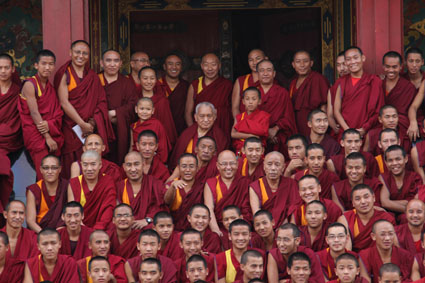Kopan Monastery – a Monastic Community

The first community of monks at Kopan was established by Lama Yeshe and Lama Zopa Rinpoche in 1972. At that time 25 monks from the Solu Khumbu region moved to Kopan and, together with a handful of monks already living there, established a program of study, meditation, and communal living under the care of Lama Yeshe. More young people arrived soon, sent by their parents or following their own calling, and soon a thriving community of monks was living on the Kopan hill. In 1981 they were joined by the first nuns - two young Tibetan women ordained by Lama Yeshe, who participated fully in the education program of the young monks, studying, memorizing and debating – things they were never able to do in Tibet.
Now monks from the age of seven from all over Nepal and other Himalayan countries are living at this Gelug monastery, one of the best in Kathmandu valley, to receive a classical monastic education. The nuns, who were part of the initial community, now live in Khachoe Ghakyil Ling Nunnery further down the hill, studying, praying and practicing. It is one of the priorities of Kopan Monastery is to nurture the aspirations of young men and women to live their lives in the footsteps of the Buddha. You are welcomed into this community as a visitor and student. We request you to respect our way of life and our values.
Monastic Community – What does it mean?

The Sangha, the community of Buddhist monks and nuns, goes back to the time of the Buddha, nearly three thousand years ago. By becoming a monk or a nun, one abandons the ways and appearance of a lay person or a house holder, and adopts the appearance and ways of an ordained person, a commitment made when accepting the ordination vows.
Historically, Sangha members are expected to preserve the doctrine and monastic discipline according to the teachings of Shakyamuni Buddha. They are also expected to be a living example for the laity, and to serve as a "field of merit" for lay followers, providing lay men and women with the opportunity to earn merit by supporting the livelihood of the monastic community. In return monks and nuns are expected to live an austere life focused on the study of Buddhist doctrine, the practice of meditation, and the observance of good moral character. The disciplinary regulations for monks and nuns are intended to create a life that is simple and focused, rather than one of deprivation or severe asceticism. Read more about the historic back ground and relevance of Monastic Communities in the next article.
Celibacy is of primary importance in monastic discipline; it is seen as being the preeminent factor in separating the life of a monastic from that of a householder. Depending on the local tradition and the strictness of observation, a monastic may eat only one meal a day, provided either by direct donations of food from lay supporters, or from a monastery kitchen that is stocked (and possibly staffed) by lay supporters.

Monastic communities can be of different kinds, depending on the special purpose they have adopted. In the Tibetan tradition, the great monastic universities focus on the in-depth academic studies of the teachings of the Buddha. At the other end of the spectrum are the smaller monasteries that serve the needs of the local community, for example by performing prayers and pujas and blessing, and providing care and education to the young monks sent by their families to join the monastery. There are communities of sangha that are in life-long retreat, others that are engaged in social service.
More and more of the monasteries now offer not only monastic training to their residents, but an all round school education to prepare the monks for a life a outside the monastery walls, serving their fellow human beings.
Not all monks are interested in pursuing a scholastic career. After finishing grade ten in the monastery school, some of them continue their monastic life by offering service to the monastery in a variety of ways. Those who wish to dedicate their life to the pursuit of religious activities may do so under the guidance of qualified teachers and meditation masters. But regardless of their small or large purposes, they all serve to preserve the teachings of Shakyamuni Buddha in its purest form for future generations.
Being a Buddhist monk or nun is truly a meaningful and worthwhile way to spend one's life, and to be of benefit to others. We are very fortunate that the monastic tradition, started by Shakyamuni Buddha more than 2500 years ago, is still alive today. Not only is there great benefit for oneself in being ordained, the life of a Buddhist monk or nun also carries a deep responsibility for oneself and for others.